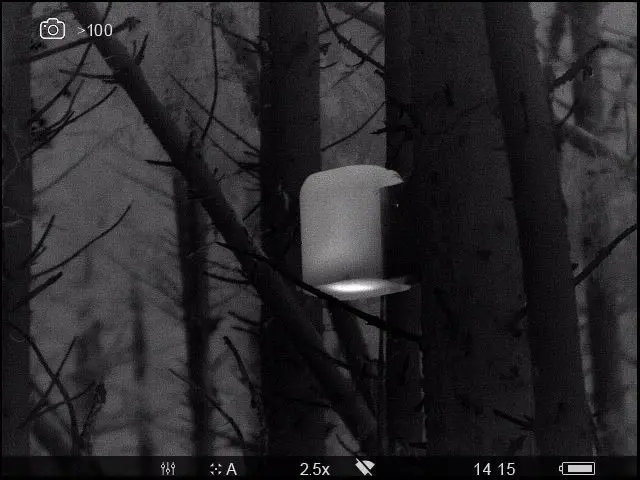Pine marten numbers on the increase in Galloway as technology trials yield positive results

Last year we posted a blog about a new trial using thermal imaging cameras to survey artificial den boxes in Galloway Forest Park. We're pleased to confirm this innovative method of monitoring pine marten boxes has been a success.
This spring, our team checked over 100 artificial nesting boxes to assess the local pine marten population, and detected a number of baby pine martens (called kits) using the technique.
Trail cameras were then fitted to 14 den boxes which provided a positive heat source (indicating evidence of occupation) in order to capture pine marten movements.
Footage captured on the cameras – fitted by the Dumfries & Galloway Pine Marten Group – shows the kits being moved at around four weeks old by the mother, one at a time, down to a denning site closer to ground level so they’re less likely to injure themselves when they become more mobile.
Our thermal imaging trials have been taking place over the last 12 months. The handheld cameras can detect a heat source in the pine marten den boxes all year round, especially during crucial periods such as in spring when pine marten kits are born and also in winter when den boxes are used for shelter in harsh weather.
Speaking about the trials, Kim Kirkbride, our Environmental Forester in the area said, “Using the non-invasive thermal imaging camera allows us to remotely monitor how many den boxes are in use, without disturbing the inhabitants.
“We can establish whether populations of pine marten are increasing and if they’re breeding successfully. Pine martens are an important factor in grey squirrel control.
“We still have to carry out grey squirrel control, but the presence of the artificial dens in the national forest estate, helps to support pine marten numbers and importantly, the survival of the reds.”
Pine martens and red squirrels
Pine martens and red squirrels happily coexist in parts of Scotland. Pine marten are known to naturally predate upon squirrels and prefer greys over red squirrels as greys appear to be slower moving, less wary and therefore easier to catch. The pine martens are a natural tool to assist in grey squirrel management.
Galloway has one of the national red squirrel strongholds. Red squirrels are under threat from ever-increasing numbers of grey squirrels due to the greys carrying ‘squirrel pox’; this disease is fatal to red squirrels who, unlike the greys, have no resistance to it.

Why build artificial boxes?
We use artificial pine marten boxes in areas where red squirrel populations are particularly under threat because pine martens are slow breeders and artificial dens can help improve breeding success locally.
Plantation or productive forests - in particular soft wood grown for timber - do not offer an abundance of the safe, warm and dry tree cavities that the martens prefer to den in.
The artificial dens are installed around four or five metres off the ground. They’re wooden boxes with roofs to keep the rain and wind out and wood shavings inside them, to make them cosy.
Last year we also announced the installation of artificial pine marten dens along the east coast of Scotland and in Perthshire to help ward off advancing grey squirrels in the region.
We hope to use this technology at other sites across Scotland to help monitor pine marten on both a local and national level.
- A83 drone seeding underway
- Thermal imaging trial helping with pine marten surveys
- What’s next for the Swinnie jigsaw